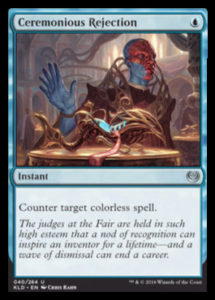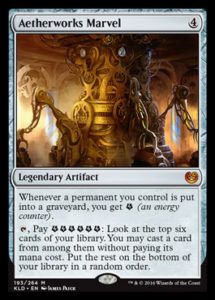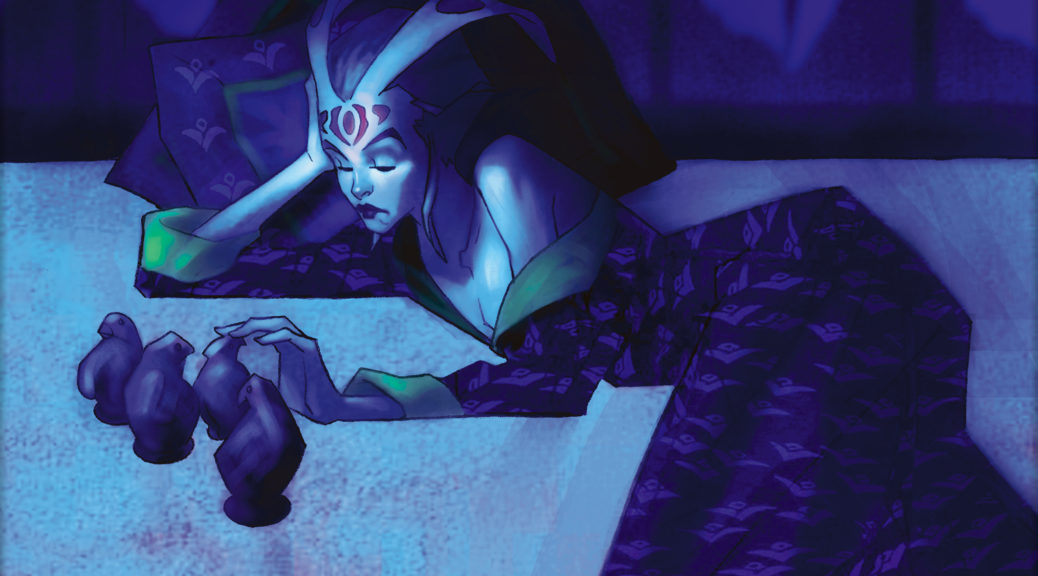Okay, so I’m going to say something that is going to sound a little extreme and “hot take”-sy, but hear me out, okay?
Kaladesh looks to me like another Kamigawa block.
This is not a slight. The Kamigawa block had a lot of issues, but the crux of a lot of them was that the block, from a development perspective, was extremely insular. Even though Spirits became a somewhat supported tribe1, things like Arcane, Samurai, and …Fox Offering (!) have yet to be seen again. Now, with regards to Standard, this does not mean that Kaladesh will not be able to have a robust impact- R&D has gotten MUCH better since CHK, so I trust them to take big swings on new blocks. This DOES mean that we are not likely to see Kaladesh mechanics have a wide impact on larger formats. What that means is going to be our focus for today, but I want to start with a couple crucial definitions that I just made up.
The Three Degrees of New Card Impact on Existing Cards/Decks:
The First Degree: Direct Support, or ‘More of a Thing’. The best example of what I’m talking about here is “tribes”. If you like to play Elves in Modern, then any new set featuring cards with elves on them is giving you new potential options. The other most common instance here is when WotC brings back an existing mechanic.
The Second Degree: Indirect Support, or ‘Similar/Related Things’. Okay, so think about Become Immense in Infect. Technically, Become Immense (or any other Giant Growth effect) is not an “Infect card”, but any new version of that type of effect is at least a consideration in Infect. This is where we are looking for related characteristics of effects, not literal uniformity. We get more second degree impact than first degree impact.
The Third Degree: Minimal Support, or ‘Standalone Things’. So this is where things get sketchy, just because most things at least interact with something. This is where we are going to plug in Energy (the new Kaladesh mechanic), because it is a fundamentally new form of resource management that has almost no relation to anything prior in Magic’s history2. Vehicles probably also fit in here, even though they are a new innovation on a long-existing card type. This is also where plane-specific tribes wind up, like the aforementioned foxes of Kamigawa, the Cephalid of Otaria, and the Gremlins of Kaladesh.
So I think that by just laying out those definitions I somewhat made the point about Kaladesh. I don’t expect Vehicles (and their associated mechanic ‘Crew’) or Energy to become evergreen staples in the Magic vocabulary, and they have little application in the world that they are entering into. The result, as it was in Kamigawa, will be that individually powerful cards will thrive outside of Standard only in instances that maximize their essential uniqueness (Gifts Ungiven, Kiki-Jiki, the Mirror Breaker). What’s nice for us on the finance side is that artifacts still play a major role on this plane, and cool and flavorful artifacts can have appeal in formats as disparate as Commander, Cube, and Vintage. Foils of Ceremonious Rejection, for example, could be very rewarding long-term holds in Vintage circles while simultaneously hitting both Tron and Eldrazi in Modern.

It’s possible that some cards involving Energy Counters could be playable in Commander, but expect them to be higher rarity and essentially standalone cards. Take, as a perfect (and potentially only) example, Aetherworks Marvel:

Because this card is able to eventually produce the effect on its own, the Es essentially operate as better Charge Counters that don’t go away when the card is destroyed. If you are able to get it back into play again later (or make a copy), then it may actually start off ahead of schedule. The checklist here is going to break down as the following:
- The card in question can make Energy counters on its own.
- The card in question has a desirable effect independent of Energy Counters.
- The card in question is unique enough to warrant play over existing options.
Aetherworks Marvel is probably best compared to Temporal Aperture, although it is able to function without any additional mana investment (although it is likely much slower). Because cards like Temporal Aperture are very few and far between, it’s likely that this is worth consideration, but be wary of something with much more mainstream comps.
I’m not going to do a “traditional” set review for Kaladesh, partially because of the reasons we outlined today, and partially because I think that WotC is printing enough product now that a card REALLY needs to be a hit in Standard to maintain a good mid-term value. So come back next week for my Standard-Centric Kaladesh Set Review, starting next week.
In the meantime, FOOTBALL IS BACK!!!!!!!!!!
DUUUUUUVAAAAAAAALLLLLLLLLLLLL,
Ross
1Although not really outside of UW, and that was only after Innistrad.
2I think you can technically proliferate Energy Counters, but let’s not be too nit-picky.
